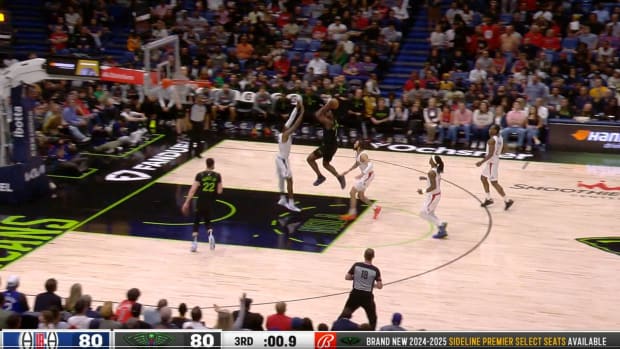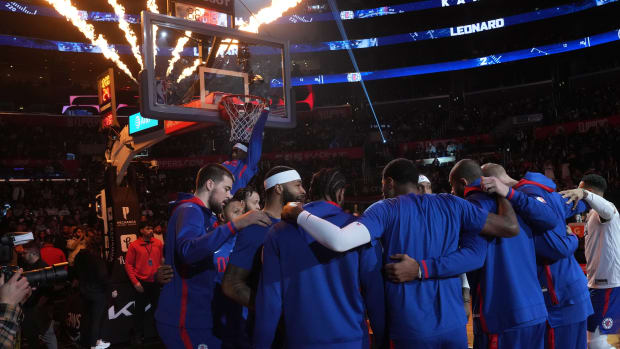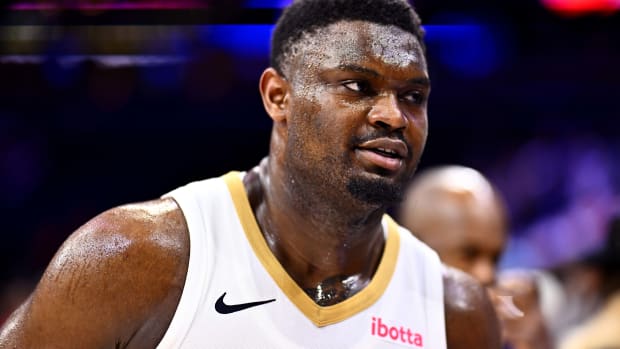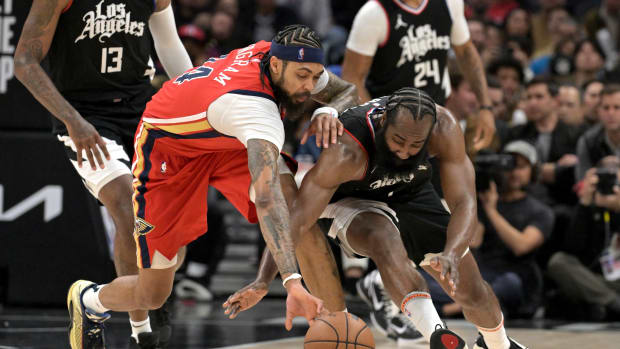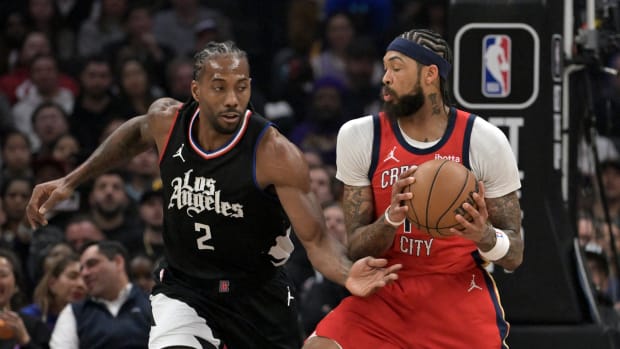LA Clippers vs. Dallas Mavericks Playoff Series Preview
LAC: 47-25 record (4th in the Western Conference); 116.7 OFFRTG (3rd in the league); 110.6 DEFRTG (8th in the league); 6.1 NETRTG (2nd in the league).
DAL: 42-30 record (5th in the Western Conference); 114.6 OFFRTG (8th in the league); 112.3 DEFRTG (21st in the league); 2.3 NETRTG (10th in the league).
Head-to-head matchup: Dallas wins regular season series 2-1
Whether there were some “bracket manipulation” shenanigans to close out the year can be argued ad nauseum, but the LA Clippers walked away from the regular season with a somewhat favorable matchup. They will be facing off against the Dallas Mavericks, a team whom LA overcame in six games last season in round one of the playoffs. Let’s examine Dallas’ roster, their strengths and weaknesses, and their previous games against the Clippers in order to determine the most likely outcome of this series.
Luka and a game of half-courts
The Mavericks’ core is essentially the same as last year: Luka Doncic, whom Clippers Head Coach Tyronn Lue deemed “the head of the snake,” is the Alpha and Omega for Dallas (he trails only Joel Embiid in terms of usage rate this season at 35%), and he’s flanked by a second (pseudo) star in Kristaps Porzingis. Dallas’ front office has done an excellent job of surrounding Doncic with shooters (Tim Hardaway Jr., Maxi Kleber) and wing defenders (Dorian Finney-Smith, new addition Josh Richardson) to make Doncic’s life slightly easier on both ends of the floor.
“What makes it so difficult to guard Luka is the dude’s built like a brick house,” Clippers guard Reggie Jackson said this week. “He’s 6’8, can pass, can put it on the deck...he’s fearless.”
Mavericks Head Coach Rick Carlisle is well aware of the gem he’s been gifted in Doncic, and knows he doesn’t need to overcomplicate his offense as a result. A screen action involving Doncicl, particularly when he’s partnered with a pick-and-pop big, is one of the more unguardable plays in basketball today, and the Mavericks go to it constantly. Doncic ranks 10th in the entire league in pick-and-roll frequency, and is averaging 1.01 points per play out of this action (more than anyone above him on this list, which includes the likes of Trae Young, Chris Paul and Ja Morant among others).
This efficiency also means that Dallas can get away with being largely a halfcourt offense. They rank 25th in the league in pace, clocking it at just under 97.94 possessions per game. Against most teams, this can be frustrating. More halfcourt possessions translates to fewer turnovers (Dallas is third-best in the league at not turning the ball over), which means fewer transition points for the opposing team.
However, the Clippers can beat the Mavericks at their own game—they hate to run, and they have no need to. they rank 28th in the league in pace (97.63 possessions per game) while still maintaining the third-best offense in the NBA. Kawhi Leonard is also a brilliant pick-and-roll player (averaging 1.11 points per play) in addition to being a dynamic postup threat, but even more crucial is the fact that the Clippers are the fourth-greatest three-point shooting team in NBA history, knocking down an absurd 41.1% of their 34.7 attempts per game. When a team is that historically efficient, there is no need to rely on transition points.
Carlisle has implemented the Milwaukee Bucks’ defensive strategy, prioritizing rim protection over defending the three-point line. Dallas allows the seventh-fewest amount of shots within five feet of the rim of any team in the league, asking bigs like Porzingis and Dwight Powell to drop back in pick-and-roll coverage (though Maxi Kleber is a great switch defender). They tend to crowd the rim on defense, sagging off of perimeter shooters; the Mavericks allow the 10th highest opponent three-point frequency in the league. Once again, a formidable strategy against lesser opponents, but it is death against the Clippers when their long-range jump shots are falling (which they do quite frequently).
Regular season games
All that being said, Dallas won the regular-season series against the Clippers two games to one, and one of those wins is widely considered the worst loss in Clipper franchise history: a 51-point blowout in which Dallas held LA to just 73 points. Was this game a complete aberration, considering the Clippers finished the season with the third-best offense in the league, averaging 116.7 points per 100 possessions?
Probably, but Dallas’ third game against the Clippers this season (in which they won 105-89) proved that they have found some sort of defensive identity against this LA squad, and that the first game was not a complete anomaly. Leonard and George scored a combined 48 points in the last game, but the Clippers were given next to nothing from their reserves. LA has since acquired more bench firepower, swapping Lou Williams for Rajon Rondo and reintegrating a now-healthy Serge Ibaka, but the lack of creation can be an issue when the occasional poor shooting performance pops up (the Clippers were 9-32 from deep in that game).
Sandwiched between these two losses was a 109-99 Clippers victory in which Doncic turned the ball over seven times. It’s hard to determine exactly how to force him into difficult decisions in pick-and-roll coverage (do you blitz, allowing the 6’7 guard to see over the defense and find the open shooter? Do you go under the screen and allow him his improved jump shot? Do you switch, and allow him to torture the opposing center in isolation?), but LA did a solid job in that particular game of making life rough on Doncic, and that quality of life is ultimately what will decide most games in this series.
“You’ve got to keep him off balance,” Lue said earlier this week when asked how the Clippers plan on defending Doncic. “He’s a great passer, great player. He’ll pick you apart if you blitz him. You can’t give him a steady diet of the same thing.”
The Porzingis wrinkle
If there is an excuse Mavericks fans can point to as to why they lost last year’s series, it’s that Porzingis was unable to play in games 4-6 after tearing his lateral meniscus in game 3. Prior to the injury, Porzingis was solid for Dallas, averaging 23.7 points and hitting 52.9% of his 5.7 three-point attempts per contest. However, the Mavericks still had a negative net rating with Porzingis on the floor, and they lost two of the three games in which he played. He’s still a unique player (a unicorn, some might say) and his ability to stretch the floor on one end while offering solid rim protection on the other will be an ongoing issue for LA. But the Clippers will no-doubt hunt him down in pick-and-roll, having whomever Porzingis is guarding set a screen for Leonard or George and force him to defend in space.
When playing at center, Porzingis will bring bigs like Ivica Zubac and Serge Ibaka out to the perimeter and away from their rim-protection assignment. Lue might elect to put the more mobile Marcus Morris Sr. on Porzingis (though he was largely given the Doncic assignment last year), but the Mavericks do not have a ton of non-shooting wings on which to hide the Clippers’ centers. If Porzingis can make the Clippers pay from deep and limit their drives to the rim, he could be an effective piece for Dallas.
Keys and predictions
The Mavericks are an excellent offensive team (though not quite as excellent as last year’s all-time great team), and they have a generational superstar in Doncic that can easily be the best player on a court that includes Leonard and George (he was for stretches both this year and last year). Doncic can flat-out win the Mavericks ball games—he literally did at the buzzer of game 4 last year. It’s a bit reductive to whittle a seven-game series down to “who has the best player,” but sometimes it is as simple as that.
However, the Clippers also have two stars with the potential to be the best player in a series. George and Leonard both reached career-highs in true-shooting percentage this year (59.8% and 62.2% respectively) and look healthy heading into the postseason. On paper, Dallas is a below-average defensive team (21st in defensive rating), and they have quite a few holes for these two wings to exploit.
It is worth noting that George did not shoot the ball well at all in last year’s series against the Mavericks (34.6% FG) or in their three regular-season games this year (37.3% FG). If George struggles yet again for whatever reason, Dallas might have an opening.
Ultimately though, this series will come down to LA’s defense of Doncic—cutting off the head of the snake, to continue Lue’s metaphor. They have plenty of like-sized bodies to throw at him; Morris drew the bulk of the assignment last year, but Leonard, George, Nicolas Batum and even Patrick Beverley will all be given a shot at shutting down the Slovenian stud. Those five players might also form the closing lineup against Dallas, allowing the Clippers to switch every pick-and-roll and not give Doncic a weak link to attack.
The Clippers are the more talented, versatile team. They have evidence that they can be successful against this Mavericks team, and should be confident entering the series. Doncic and co. will put up a fight, grinding out each game with extended possessions and endless on-ball screens and re-screens, and this could win them a game or two. Ultimately, though, LA’s combination of defensive length, shooting and midrange scoring should prevail.
Prediction: Clippers win in six games.
Related Stories
LA Clippers Player Grades for the 2020-21 Regular Season
Luka Doncic Reveals Thoughts About Facing LA Clippers in Playoffs Again
Tyronn Lue Discusses Strategy for Playoff Matchup vs. Dallas Mavericks

